Mazda CX-9 (2022 year). Manual in english — page 21
Customer Information and Reporting Safety Defects
Warranty
Add-On Non-Genuine Parts and Accessories
Non-genuine parts and accessories for Mazda vehicles can be found in stores.
These may fit your vehicle, but they are not approved by Mazda for use with Mazda
vehicles. When you install non-genuine parts or accessories, they could affect your vehicle's
performance or safety systems; the Mazda warranty doesn't cover this. Before you install
any non-genuine parts or accessories, consult an Authorized Mazda Dealer.
WARNING
Always consult an Authorized Mazda Dealer before you install non-genuine parts or
accessories:
Improperly designed parts or accessories could seriously affect your vehicle's performance or
safety systems. This could cause you to have an accident or increase your chances of injuries
in an accident.
Be very careful in choosing and installing add-on electrical equipment, such as mobile
telephones, two-way radios, stereo systems, and car alarm systems:
Incorrectly choosing or installing improper add-on equipment or choosing an improper
installer is dangerous. Essential systems could be damaged, causing engine stalling, air-bag
(SRS) activation, ABS/TCS/DSC inactivation, or a fire in the vehicle.
Mazda assumes no responsibility for death, injury, or expenses that may result from the
installation of add-on non-genuine parts or accessories.
8-19
Customer Information and Reporting Safety Defects
Cell Phones
Cell Phones Warning
WARNING
Please comply with the legal regulations concerning the use of communication equipment in
vehicles in your country:
Use of any electrical devices such as cell phones, computers, portable radios, vehicle
navigation or other devices by the driver while the vehicle is moving is dangerous. Dialing a
number on a cell phone while driving also ties-up the driver's hands. Use of these devices will
cause the driver to be distracted and could lead to a serious accident. If a passenger is unable
to use the device, pull off the right-of-way to a safe area before use. If use of a cell phone is
necessary despite this warning, use a hands-free system to at least leave the hands free to
drive the vehicle. Never use a cell phone or other electrical devices while the vehicle is moving
and, instead, concentrate on the full-time job of driving.
8-20
Customer Information and Reporting Safety Defects
Event Data Recorder
Event Data Recorder (U.S.A. and Canada)
This vehicle is equipped with an event data recorder (EDR). The main purpose of an EDR is
to record, in certain crash or near crash-like situations, such as an air bag deployment or
hitting a road obstacle, data that will assist in understanding how a vehicle’s systems
performed. The EDR is designed to record data related to vehicle dynamics and safety
systems for a short period of time, typically 30 seconds or less. The EDR in this vehicle is
designed to record such data as:
How various systems in your vehicle were operating;
Whether or not the driver and passenger safety belts were buckled/fastened;
How far (if at all) the driver was depressing the accelerator and/or brake pedal; and,
How fast the vehicle was traveling.
These data can help provide a better understanding of the circumstances in which crashes
and injuries occur.
NOTE:
EDR data are recorded by your vehicle only if a non-trivial crash or near crash-like situation
occurs; no data are recorded by the EDR under normal driving conditions and no personal
data (e.g., name, gender, age, and crash location) are recorded. However, other parties, such
as law enforcement, could combine the EDR data with the type of personally identifying
data routinely acquired during a crash investigation.
To read data recorded by an EDR, special equipment is required, and access to the vehicle or
the EDR is needed. In addition to the vehicle manufacturer, other parties, such as law
enforcement, that have the special equipment, can read the information if they have access
to the vehicle or the EDR.
Mazda will not disclose any of the data recorded in an EDR to a third party unless:
A written agreement from the vehicle owner or the lessee is obtained
Officially requested by the police or other law enforcement authorities
Used as a defense for Mazda in a lawsuit, claim, or arbitration
Ordered by a judge or court
However, if necessary Mazda will:
Use the data for research on Mazda vehicle performance, including safety.
Disclose the data or the summarized data to a third party for research purposes without
disclosing vehicle or owner identification information.
8-21
Customer Information and Reporting Safety Defects
Recording of Vehicle Data
Recording of Vehicle Data
This vehicle is equipped with a computer which records the following main vehicle data
related to vehicle controls, operation, and other driving conditions.
Recorded data
Vehicle conditions such as engine speed and vehicle speed
Driving operation conditions such as accelerator and brake pedals, and information related
to the environmental circumstances while the vehicle is driven
Malfunction diagnosis information from each on-vehicle computer
Information related to controls of other on-vehicle computers
NOTE
The recorded data may vary depending on the vehicle grade and optional equipment. Voice
and images are not recorded.
Data handling
Mazda and its subcontracting parties may obtain and use the recorded data for vehicle
malfunction diagnosis, research and development, and quality improvement.
Mazda will not disclose or provide any of the obtained data to a third party unless:
An agreement from the vehicle owner (agreements from lessor and lessee for leased
vehicle) is obtained
Officially requested by the police or other law enforcement authorities
For statistical processing by a research institution after processing the data so that
identification of the owner or the vehicle is impossible
8-22
Customer Information and Reporting Safety Defects
Uniform Tire Quality Grading System (UTQGS)
Uniform Tire Quality Grading System (UTQGS)
This information relates to the tire grading system developed by the U.S. National Highway
Traffic Safety Administration for grading tires by tread wear, traction, and temperature
performance.
▼ Tread Wear
The tread wear grade is a comparative rating based on the wear rate of the tire when tested
under controlled conditions on a specified government test course.
For example, a tire graded 150 would wear one-and-a-half times as well on the government
course as a tire graded 100.
The relative performance of tires depends upon the actual conditions of their use, however,
and may depart significantly from the norm because of variations in driving habits, service
practices and differences in road characteristics and climate.
▼ Traction-AA, A, B, C
The traction grades, from highest to lowest, are AA, A, B, and C. These grades represent the
tire's ability to stop on wet pavement as measured under controlled conditions on specified
government test surfaces of asphalt and concrete. A tire marked C may have poor traction
performance.
WARNING
The traction grade assigned to this tire is based on braking (straight ahead) traction tests and
does not include acceleration cornering (turning), hydroplaning, or peak traction
characteristics.
▼ Temperature-A, B, C
The temperature grades A (the highest), B, and C, represent the tire's resistance to the
generation of heat and its ability to dissipate heat when tested under controlled conditions
on a specified indoor laboratory test wheel.
Sustained high temperature can cause the material of the tire to degenerate and reduce tire
life, and excessive temperatures can lead to sudden tire failure.
Grade C corresponds to a level of performance which all passenger vehicle tires must meet
under the Federal Motor Vehicle Safety Standard No. 109. Grades B and A represent higher
levels of performance on the laboratory test wheel than the minimum required by law.
8-23

Customer Information and Reporting Safety Defects
Uniform Tire Quality Grading System (UTQGS)
WARNING
Keep your vehicle's tires properly inflated and not overloaded:
Driving with improperly inflated or overloaded tires is dangerous. Excessive speed,
underinflation, or excessive loading, either separately or in combination, can cause heat
buildup and possible tire failure. The temperature grade for this tire is established for a tire
that is properly inflated and not overloaded.
These grades will be added to the sidewalls of passenger vehicle tires over the next several
years according to a schedule established by the NHTSA and the tire manufacturers.
The grade of tires available as standard or optional equipment on Mazda vehicles may vary
with respect to grade.
ALL PASSENGER VEHICLE TIRES MUST CONFORM TO THESE GRADES AND TO
ALL OTHER FEDERAL TIRE-SAFETY REQUIREMENTS.
▼ UNIFORM TIRE QUALITY GRADING
Quality grades can be found where applicable on the tire sidewall between tread shoulder
and maximum section width.
For example:
TREADWEAR 200 TRACTION AA TEMPERATURE A
UTQGS MARK (example)
8-24

Customer Information and Reporting Safety Defects
Tire Information (U.S.A.)
Tire Labeling
Federal law requires tire manufacturers to place standardized information on the sidewall of
all tires. This information identifies and describes the fundamental characteristics of the tire
and also provides a tire identification number for safety standard certification and in case of
a recall.
▼ Information on Passenger Vehicle Tires
Please refer to the sample below.
1. TIN: U.S. DOT tire identification number
2. Passenger car tire
3. Nominal width of tire in millimeters
4. Ratio of height to width (aspect ratio)
5. Radial
6. Run-flat tire
7. Rim diameter code
8. Load index & speed symbol
9. Severe snow conditions
10. Tire ply composition and materials used
11. Max. load rating
12. Tread wear, traction and temperature grades
13. Max. permissible inflation pressure
14. SAFETY WARNING
8-25

Customer Information and Reporting Safety Defects
Tire Information (U.S.A.)
P215/65R15 95H is an example of a tire size and load index rating. Here is an explanation
of the various components of that tire size and load index rating. Note that the tire size and
load index rating may be different from the example.
P
Indicates a tire that may be installed on cars, SUVs, minivans and light trucks as designated
by the Tire and Rim Association (T&RA).
NOTE
If your tire size does not begin with a letter this may mean it is designated by either ETRTO
(European Tire and Rim Technical Organization) or JATMA (Japan Tire Manufacturing
Association).
215
“215” is the nominal width of the tire in millimeters. This three-digit number gives the
width in millimeters of the tire from sidewall edge to sidewall edge. In general, the larger
the number, the wider the tire.
65
“65” is the aspect ratio. This two-digit number indicates the tire's ratio of height to width.
R
“R” is the tire construction symbol. R indicates “Radial ply construction”.
15
“15” is the wheel rim diameter in inches.
95
“95” is the Load Index. This two-or three-digit number indicates how much weight each tire
can support.
H
“H” is the speed rating. The speed rating denotes the maximum speed for which the use of
the tire is rated.
Letter Rating
Speed Rating
Q
99 mph
R
106 mph
S
112 mph
T
118 mph
U
124 mph
H
130 mph
8-26

Customer Information and Reporting Safety Defects
Tire Information (U.S.A.)
Letter Rating
Speed Rating
V
149 mph
W
168* mph
Y
186* mph
* For tires with a maximum speed capability over 149 mph, tire manufacturers sometimes use the letters ZR. For
tires with a maximum speed capability over 186 mph, tire manufacturers always use the letters ZR.
M S or M/S: Mud and Snow
AT: All Terrain.
AS: All Season. The “M S” or “M/S” indicates that the tire has some functional use in mud
and snow.
U.S. DOT Tire Identification Number (TIN)
This begins with the letters “DOT” which indicates the tire meets all federal standards. The
next two numbers or letters are the plant code where it was manufactured, and the last four
numbers represent the week and year the tire was manufactured. For example, the numbers
457 means the 45st week of 1997. After 2000 the numbers go to four digits. For example,
the number 2102 means the 21th week of 2002. The other numbers are marketing codes
used at the manufacturer's discretion. This information is used to contact consumers if a tire
defect requires a recall.
Tire Ply Composition and Materials Used
The number of plies indicates the number of layers of rubber-coated fabric in the tire. In
general, the greater the number of plies, the more weight a tire can support. Tire
manufacturers also must indicate the tire materials, which include steel, nylon, polyester,
and other.
Maximum Load Rating
This number indicates the maximum load in kilograms and pounds that can be carried by the
tire.
Maximum Permissible Inflation Pressure
This number is the greatest amount of air pressure that should ever be put in the tire under
normal driving conditions.
Tread Wear, Traction and Temperature Grades
Tread wear: The tread wear grade is a comparative rating based on the wear rate of the tire
when tested under controlled conditions on a specified government test course. For
example, a tire graded 150 would wear one and one-half (1 1/2) times as well on the
government course as a tire graded 100.
8-27
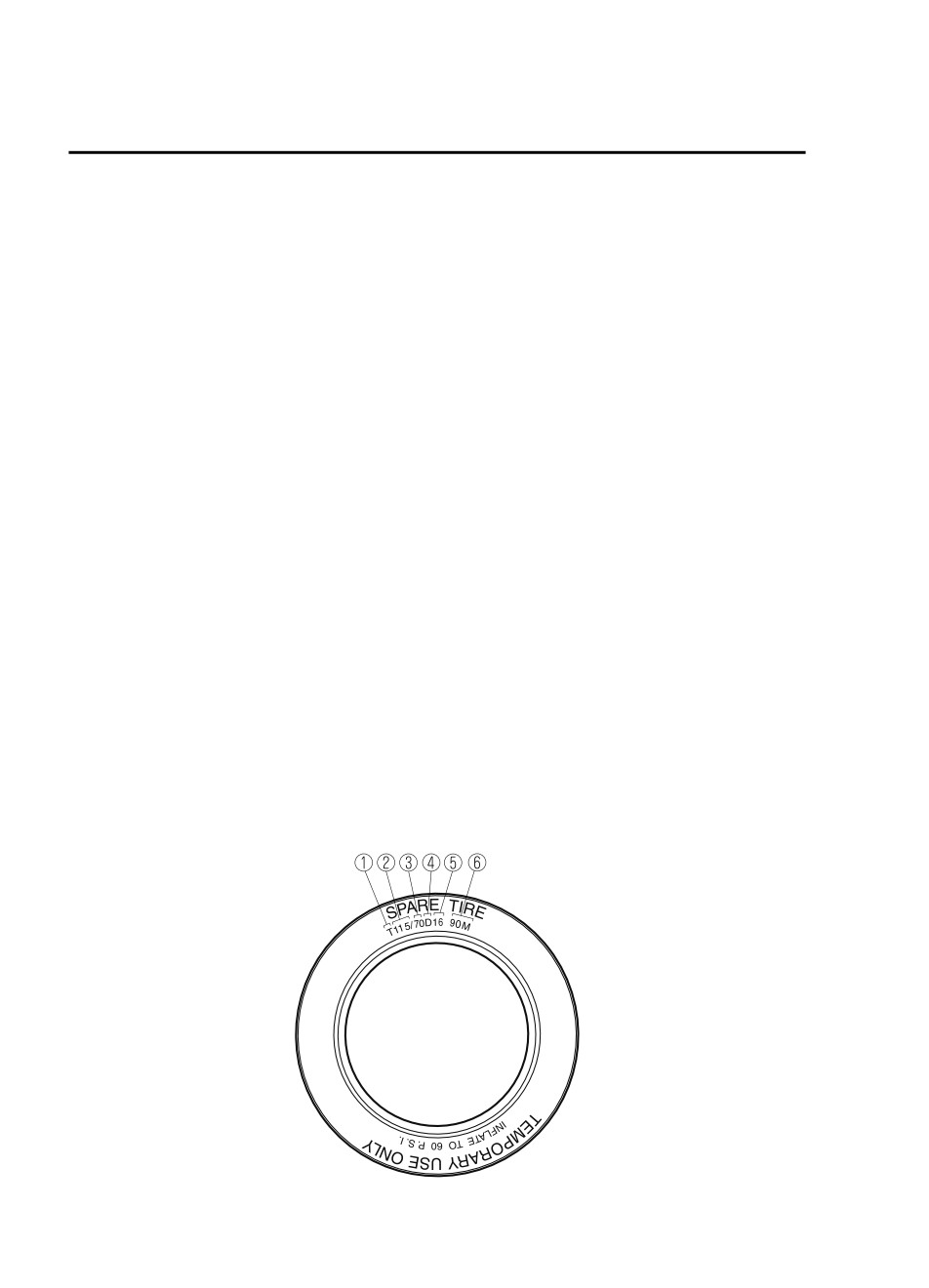
Customer Information and Reporting Safety Defects
Tire Information (U.S.A.)
Traction: The traction grades, from highest to lowest are AA, A, B, and C. The grades
represent the tire's ability to stop on wet pavement as measured under controlled conditions
on specified government test surfaces of asphalt and concrete. A tire marked C may have
poor traction performance.
Temperature: The temperature grades are A (the highest), B and C, representing the tire's
resistance to the generation of heat and its ability to dissipate heat when tested under
controlled conditions on a specified indoor laboratory test wheel.
Snow Tires
In some heavy snow areas, local governments may require true snow tires, those with very
deeply cut tread. These tires should only be used in pairs or placed on all four wheels. Make
sure you purchase snow tires that are the same size and construction type as the other tires
on your vehicle.
SAFETY WARNING
The following safety warning appears on the tire's sidewall.
SERIOUS INJURY MAY RESULT FROM:
EXPLOSION OF TIRE/RIM ASSEMBLY DUE TO IMPROPER MOUNTING-MATCH
TIRE DIAMETER TO RIM DIAMETER; NEVER EXCEED 40 psi (275 kPa) TO SEAT
BEADS-ONLY SPECIALLY TRAINED PERSONS SHOULD MOUNT TIRES.
TIRE FAILURE DUE TO UNDER-INFLATION/OVERLOADING/
DAMAGE-FOLLOW OWNER'S MANUAL AND PLACARD IN
VEHICLE-FREQUENTLY CHECK INFLATION PRESSURE AND INSPECT FOR
DAMAGE.
▼ Information on Temporary Tires
Please refer to the sample below.
8-28
Customer Information and Reporting Safety Defects
Tire Information (U.S.A.)
1. Temporary tires
2. Nominal width of tire in millimeters
3. Ratio of height to width (aspect ratio)
4. Diagonal
5. Rim diameter code
6. Load index & speed symbol
T115/70D16 90M is an example of a tire size and load index rating. Here is an explanation
of the various components of that tire size and load index rating. Note that the tire size and
load index rating may be different from the example.
T
Indicates a tire that may be installed on cars, SUVs, minivans and light trucks as designated
by the Tire and Rim Association (T&RA).
115
“115” is the nominal width of the tire in millimeters. This three-digit number gives the
width in millimeters of the tire from sidewall edge to sidewall edge. In general, the larger
the number, the wider the tire.
70
“70” is the aspect ratio. This two-digit number indicates the tire's ratio of height to width.
D
“D” is the tire construction symbol. D indicates “diagonal ply construction”.
16
“16” is the wheel rim diameter in inches.
90
“90” is the Load Index. This two-or three-digit number indicates how much weight each tire
can support.
M
“M” is the speed rating. The speed rating denotes the maximum speed for which the use of
the tire is rated.
Letter Rating
Speed Rating
M
81 mph
8-29
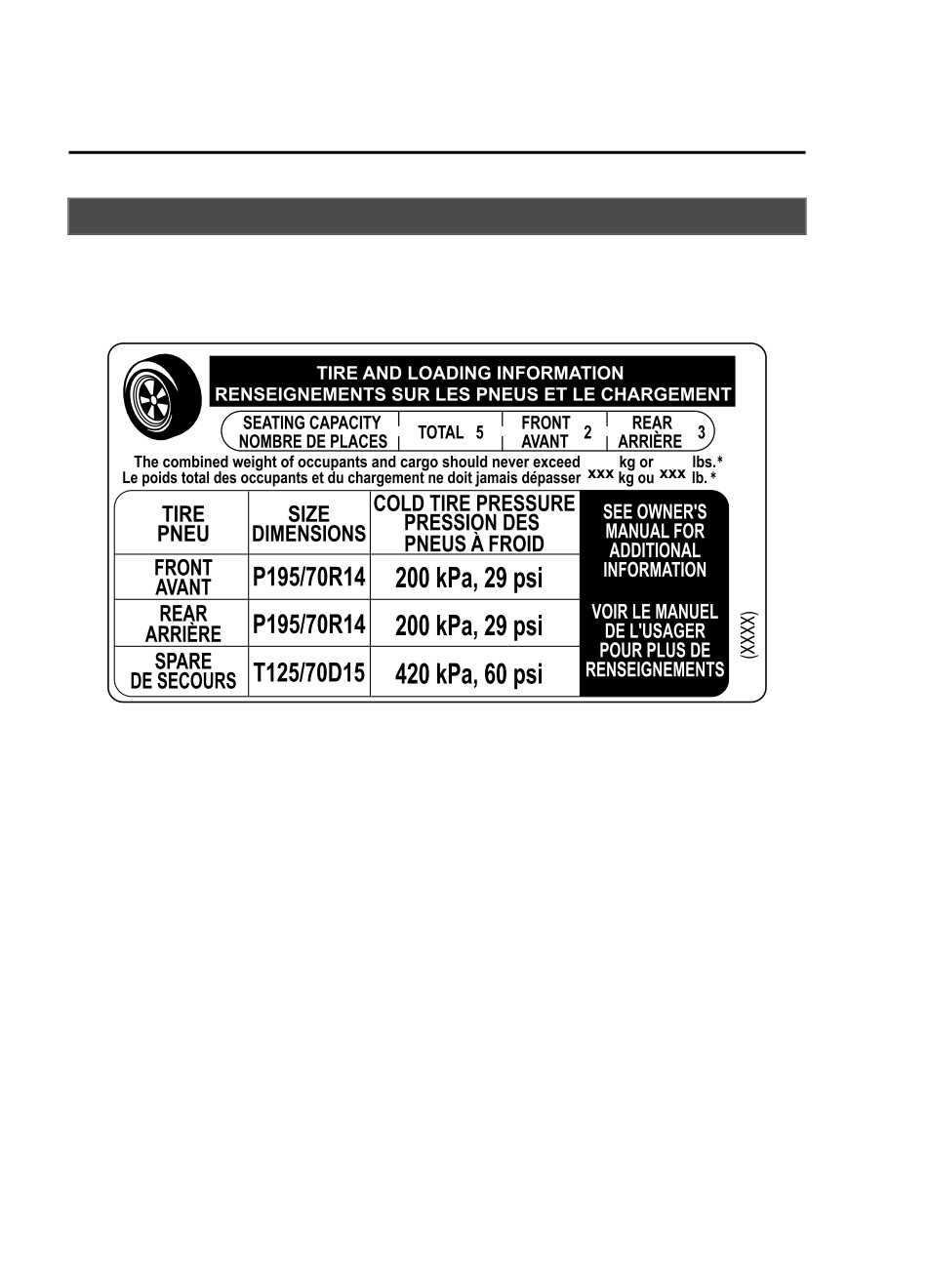
Customer Information and Reporting Safety Defects
Tire Information (U.S.A.)
Location of the Tire Label (Placard)
You will find the tire label containing tire inflation pressure by tire size and other important
information on the driver's side B-pillar or on the edge of the driver's door frame.
SAMPLE
▼ Recommended Tire Inflation Pressure
On the tire label you will find the recommended tire inflation pressure in both kPa and psi
for the tires installed as original equipment on the vehicle. It is very important that the
inflation pressure of the tires on your vehicle is maintained at the recommended pressure.
You should check the tire pressure regularly to insure that the proper inflation pressure is
maintained.
Refer to Tires on page 9-7.
NOTE
Tire pressures listed on the vehicle placard or tire information label indicate the
recommended cold tire inflation pressure, measured when the tires are cold, after the vehicle
has been parked for at least 3 hours. As you drive, the temperature in the tire warms up,
increasing the tire pressure.
8-30
Customer Information and Reporting Safety Defects
Tire Information (U.S.A.)
WARNING
Always check the tire inflation pressures on a regular basis according to the recommended
tire inflation pressure on the tire label and in conjunction with the information in this owner's
manual:
Driving your vehicle with under-inflated tires is dangerous.
Under-inflation is the most common cause of failures in any kind of tire and may result in
severe cracking, tread separation or “blowout”, with unexpected loss of vehicle control and
increased risk of injury. Under-inflation increases sidewall flexing and rolling resistance,
resulting in heat buildup and internal damage to the tire. It results in unnecessary tire stress,
irregular wear, loss of control and accidents. A tire can lose up to half of its air pressure and
not appear to be flat!
It is impossible to determine whether or not tires are properly inflated just by looking at them.
▼ Checking Tire Pressure
1. When you check the air pressure, make sure the tires are cold ―meaning they are not
hot from driving even a mile.
2. Remove the cap from the valve on one tire.
3. Firmly press a tire gauge onto the valve.
4. Add air to achieve recommended air pressure.
5. If you overfill the tire, release air by pushing on the metal stem in the center of the
valve. Then recheck the pressure with your tire gauge.
6. Replace the valve cap.
7. Repeat with each tire, including the spare.
NOTE
Some spare tires require higher inflation pressure.
8. Visually inspect the tires to make sure there are no nails or other objects embedded that
could poke a hole in the tire and cause an air leak.
9. Check the sidewalls to make sure there are no gouges, cuts, bulges, cracks or other
irregularities.
▼ Glossary of Terms
Tire Placard: A label indicating the OE tire sizes, recommended inflation pressure, and the
maximum weight the vehicle can carry.
Tire Identification Number (TIN): A number on the sidewall of each tire providing
information about the tire brand and manufacturing plant, tire size, and date of manufacture.
Inflation Pressure: A measure of the amount of air in a tire.
kPa: Kilopascal, the metric unit for air pressure.
psi: Pounds per square inch, the English unit for air pressure.
B-pillar: The structural member at the side of the vehicle behind the front door.
8-31
Customer Information and Reporting Safety Defects
Tire Information (U.S.A.)
Original Equipment (OE): Describes components originally equipped on the vehicle.
Vehicle Load Limit: The maximum value of the combination weight of occupants and
cargo.
Bead Area of the Tire: Area of the tire next to the rim.
Sidewall Area of the Tire: Area between the bead area and the tread.
Tread Area of the Tire: Area on the perimeter of the tire that contacts the road when it's
mounted on the vehicle.
Seating capacity means the total allowable number of vehicle occupants. Seating capacity
is described on the tire label.
Production options weight is the combination weight of installed regular production
options weighing over 2.3 kilograms in excess of the standard items which they replace, and
not previously considered in the curb weight or accessory weight, including heavy duty
brakes, ride levelers, roof rack, heavy duty battery, and special trim.
Rim is the metal support (wheel) for a tire or a tire and tube assembly upon which the tire
beads are seated.
8-32
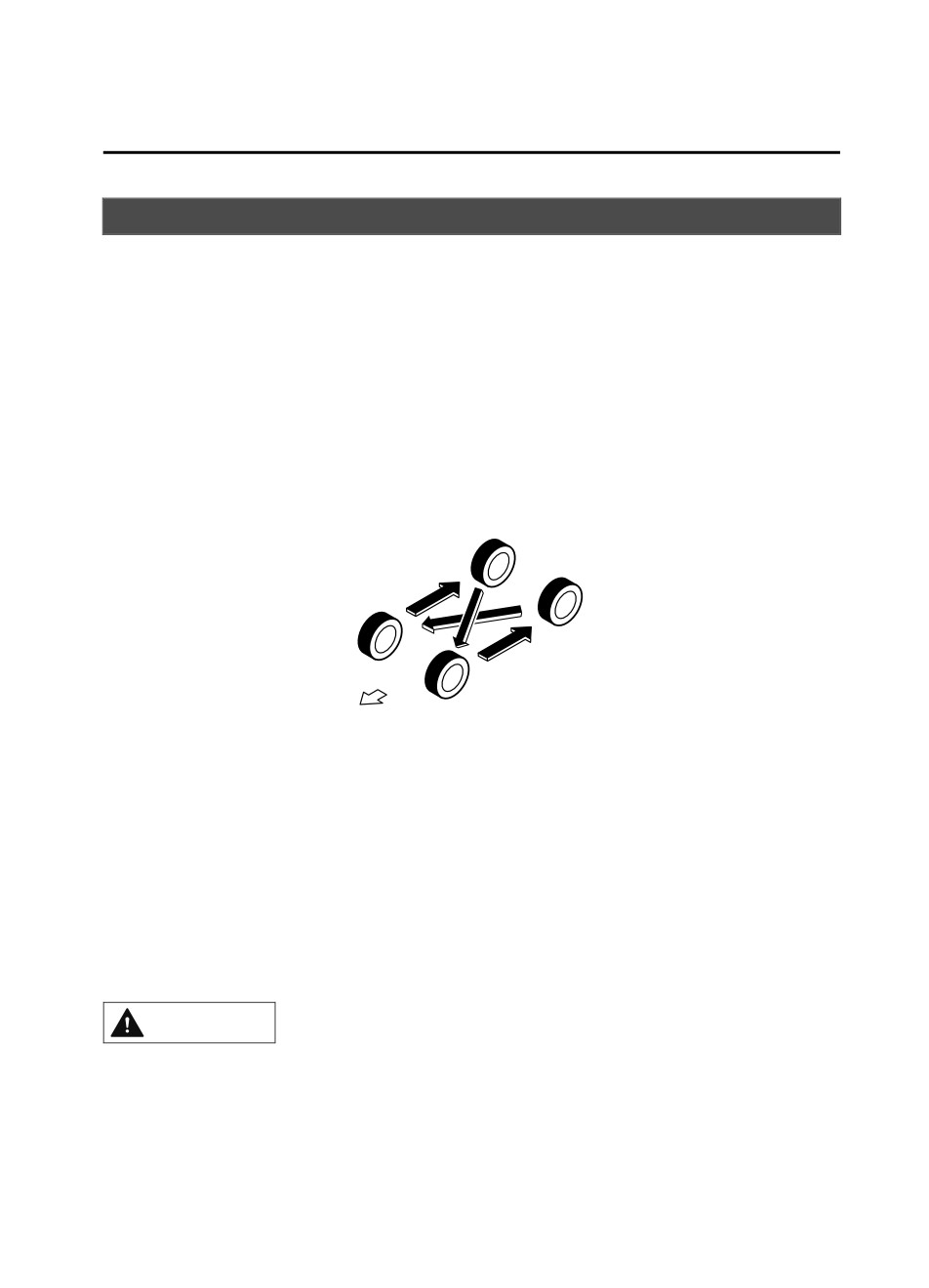
Customer Information and Reporting Safety Defects
Tire Information (U.S.A.)
Tire Maintenance
Improper or inadequate vehicle maintenance can cause tires to wear abnormally. Here are
some important maintenance points:
▼ Tire Inflation Pressure
Inspect all tire pressure monthly (including the spare) when the tires are cold. Maintain
recommended pressures for the best ride, top handling, and minimum tire wear. Use the
pressures specified on the vehicle tire information placard or tire label for optimum service.
▼ Tire Rotation
To equalize tread wear, rotate the tires every 12,000 km (7,500 miles) at the latest or sooner
if irregular wear develops. Mazda recommends to rotate every 8,000 km (5,000 miles) to
help increase tire life and distribute wear more evenly.
Forward
Do not include (TEMPORARY USE ONLY)
spare tire in rotation.
Inspect the tires for uneven wear and damage. Abnormal wear is usually caused by one or a
combination of the following:
Incorrect tire pressure
Improper wheel alignment
Out-of-balance wheel
Severe braking
After rotation, inflate all tire pressures to specification (page 9-7) and inspect the lug nuts
for tightness.
CAUTION
Rotate unidirectional tires and radial tires that have an asymmetrical tread pattern or studs
only from front to rear, not from side to side. Tire performance will be weakened if rotated
from side to side.
8-33
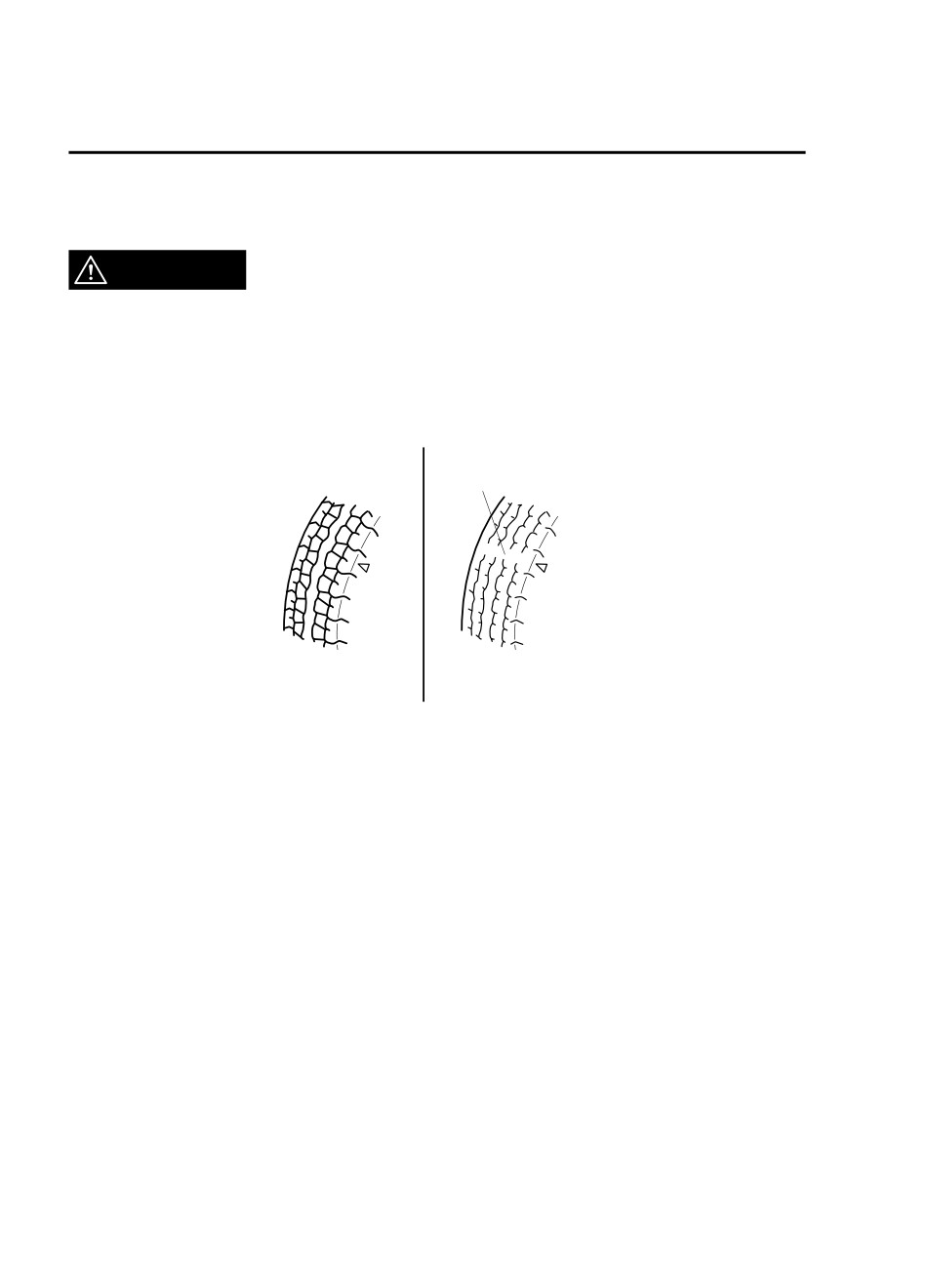
Customer Information and Reporting Safety Defects
Tire Information (U.S.A.)
▼ Replacing a Tire
WARNING
Always use tires that are in good condition:
Driving with worn tires is dangerous. Reduced braking, steering, and traction could result in
an accident.
If a tire wears evenly, a wear indicator will appear as a solid band across the tread.
Replace the tire when this happens.
Tread wear indicator
New tread
Worn tread
You should replace the tire before the band crosses the entire tread.
NOTE
Tires degrade over time, even when they are not being used on the road. It is recommended
that tires generally be replaced when they are 6 years or older. Heat caused by hot climates
or frequent high loading conditions can accelerate the aging process. You should replace
the spare tire when you replace the other road tires due to the aging of the spare tire. The
period in which the tire was manufactured (both week and year) is indicated by a 4-digit
number.
Refer to Tire Labeling on page 8-25.
▼ Safety Practices
The way you drive has a great deal to do with your tire mileage and safety. So cultivate
good driving habits for your own benefit.
Observe posted speed limits and drive at speeds that are safe for the existing weather
conditions
Avoid fast starts, stops and turns
Avoid potholes and objects on the road
Do not run over curbs or hit the tire against the curb when parking
8-34
Customer Information and Reporting Safety Defects
Tire Information (U.S.A.)
CAUTION
If you feel a sudden vibration or ride disturbance while driving or you suspect your tire or
vehicle has been damaged, immediately reduce your speed. Drive with caution until you can
safely pull off the road. Stop and inspect the tire for damage. If the tire is under-inflated or
damaged, deflate it, remove the tire and rim and replace it with your spare tire. If you cannot
detect a cause, have the vehicle towed to the nearest vehicle or tire dealer to have the vehicle
inspected.
8-35
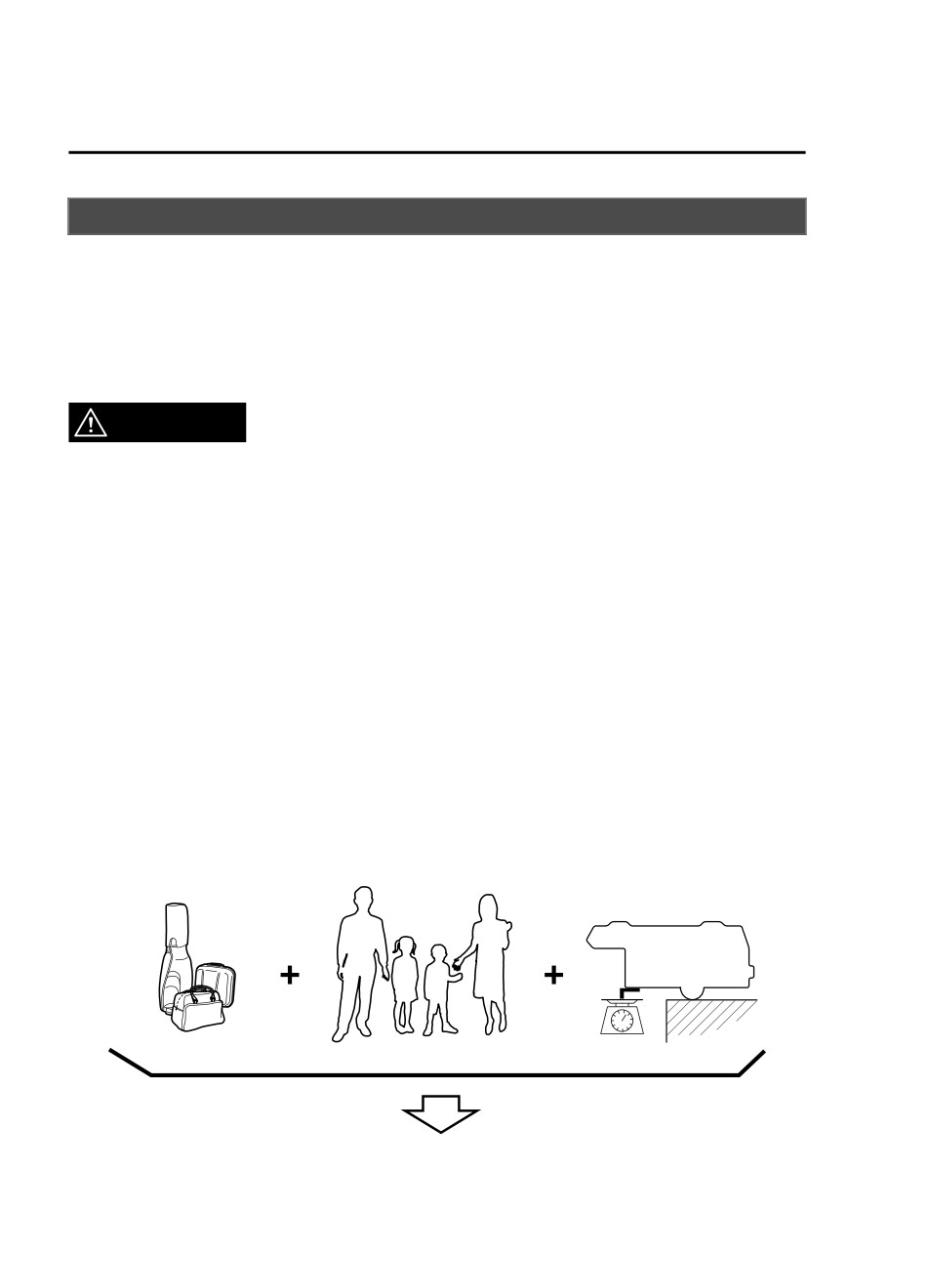
Customer Information and Reporting Safety Defects
Tire Information (U.S.A.)
Vehicle Loading
This section will guide you in the proper loading of your vehicle and/or trailer, to keep your
loaded vehicle weight within its design rating capability, with or without a trailer. Properly
loading your vehicle will provide maximum return of vehicle design performance. Before
loading your vehicle, familiarize yourself with the following terms for determining your
vehicle's weight ratings, with or without a trailer, from the vehicle's Safety Certification
Label and Tire and Load Information Label:
WARNING
Overloaded Vehicle:
Overloading a vehicle is dangerous. The results of overloading can have serious consequences
in terms of passenger safety. Too much weight on a vehicle's suspension system can cause
spring or shock absorber failure, brake failure, handling or steering problems, irregular tire
wear, tire failure or other damage.
Overloading makes a vehicle harder to drive and control. It also increases the distance
required for stopping. In cases of serious overloading, brakes can fail completely, particularly
on steep grades. The load a tire will carry safely is a combination of the size of the tire, its load
range, and corresponding inflation pressure.
Never overload the vehicle and always observe the vehicle's weight ratings from the vehicle's
Safety Certification and Tire and Load Information labels.
Base Curb Weight is the weight of the vehicle including a full tank of fuel and all
standard equipment. It does not include passengers, cargo, or optional equipment.
Vehicle Curb Weight is the weight of your new vehicle when you picked it up from your
dealer plus any aftermarket equipment.
PAYLOAD
8-36
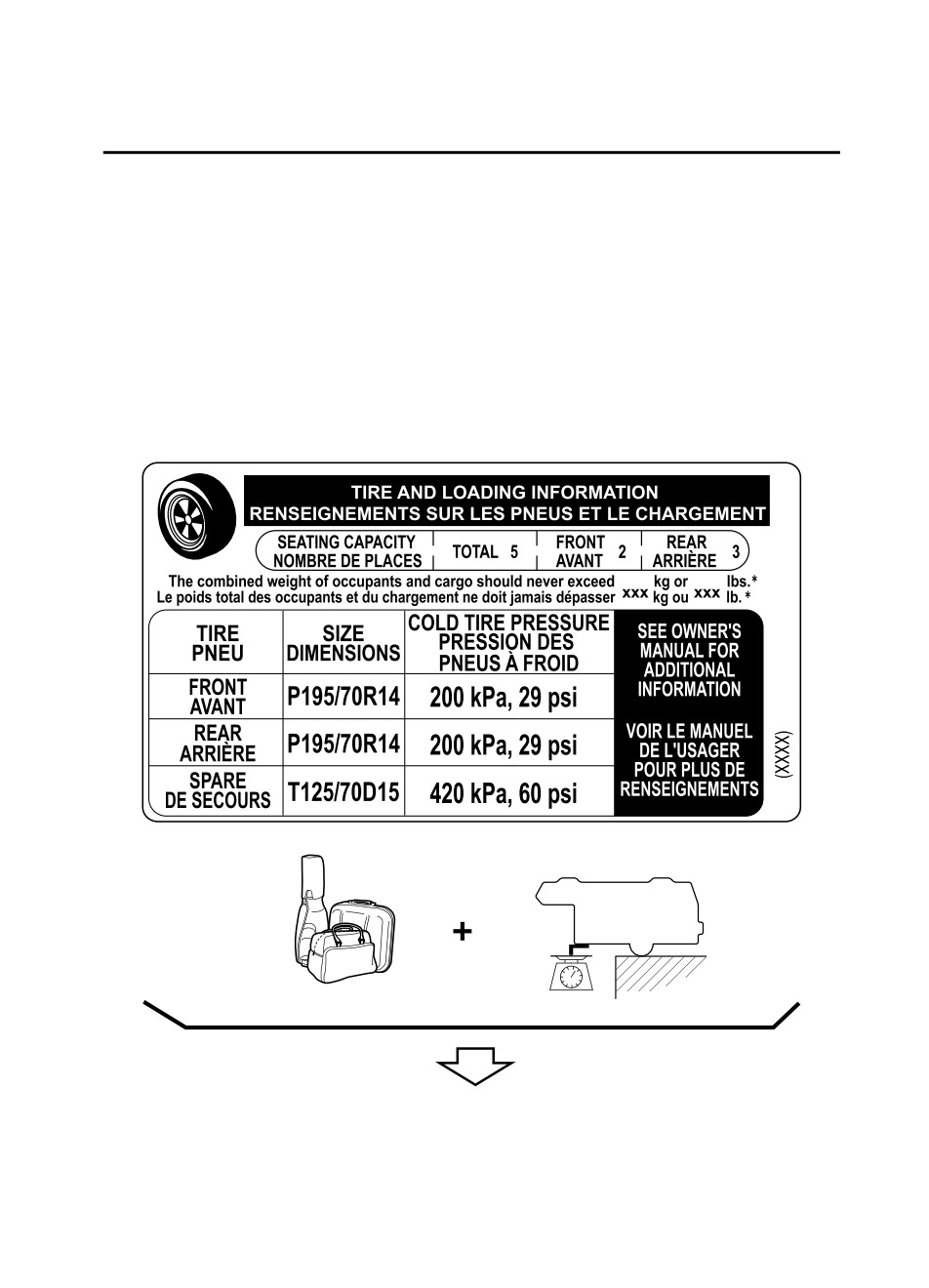
Customer Information and Reporting Safety Defects
Tire Information (U.S.A.)
Payload is the combination weight of cargo and passengers that the vehicle is designed to
carry. The maximum payload for your vehicle can be found on the Tire and Load
Information label on the driver's door frame or door pillar. Look for “THE COMBINATION
WEIGHT OF OCCUPANTS AND CARGO SHOULD NEVER EXCEED XXX kg or XXX
lbs” for your maximum payload. The payload listed on the tire label is the maximum
payload for the vehicle as built by the assembly plant. If any aftermarket or dealer installed
equipment has been installed on the vehicle, the weight of the equipment must be subtracted
from the payload listed on the tire label in order to be accurate.
SAMPLE
CARGO
8-37

Customer Information and Reporting Safety Defects
Tire Information (U.S.A.)
Cargo Weight includes all weight added to the Base Curb Weight, including cargo and
optional equipment. When towing, trailer tongue load or king pin weight is also part of
cargo weight.
The cargo weight limit decreases depending on the number of vehicle occupants. The cargo
weight limit can be calculated by subtracting the total weight of the vehicle occupants from
the “combination weight of occupants and cargo should never exceed” value on the tire
label.
Examples: Based on a single occupant weight of 68 kg (150 lbs), and a value of 385 kg (849
lbs) for the “combination weight of occupants and cargo should never exceed”:
The cargo weight limit with one occupant is 385 kg (849 lbs) - 68 kg (150 lbs) = 317 kg
(699 lbs)
The cargo weight limit with two occupants is 385 kg (849 lbs) - (68 × 2) kg ( (150 × 2)
lbs) = 249 kg (549 lbs)
If the weight of the occupant increases, the cargo weight limit decreases by that much.
GAW (Gross Axle Weight) is the total weight placed on each axle (front and rear) -
including vehicle curb weight and all payload.
GAWR (Gross Axle Weight Rating) is the maximum allowable weight that can be carried
by a single axle (front or rear). These numbers are shown on the Safety Compliance
Certification Label located on the driver's door frame or door pillar. The total load on
each axle must never exceed its GAWR.
GVW
GVW (Gross Vehicle Weight) is the Vehicle Curb Weight cargo passengers.
GVWR (Gross Vehicle Weight Rating) is the maximum allowable weight of the fully
loaded vehicle (including all options, equipment, passengers and cargo). The GVWR is
8-38

Customer Information and Reporting Safety Defects
Tire Information (U.S.A.)
shown on the Safety Compliance Certification Label located on the driver's door
frame or door pillar. The GVW must never exceed the GVWR.
SAMPLE
WARNING
Never Exceed Axle Weight Rating Limits:
Exceeding the Safety Certification Label axle weight rating limits is dangerous and could
result in death or serious injury as a result of substandard vehicle handling, performance,
engine, transmission and/or structural damage, serious damage to the vehicle, or loss of
control.
Always keep the vehicle within the axle weight rating limits.
GCW
8-39
Customer Information and Reporting Safety Defects
Tire Information (U.S.A.)
GCW (Gross Combination Weight) is the weight of the loaded vehicle (GVW) plus the
weight of the fully loaded trailer.
GCWR (Gross Combination Weight Rating) is the maximum allowable weight of the
vehicle and the loaded trailer - including all cargo and passengers - that the vehicle can
handle without risking damage. (Important: The towing vehicle's braking system is rated for
operation at GVWR, not at GCWR. Separate functional brakes should be used for safe
control of towed vehicles and for trailers weighing more than 1,500 lbs). The GCW must
never exceed the GCWR.
Maximum Loaded Trailer Weight is the highest possible weight of a fully loaded trailer
the vehicle can tow. It assumes a vehicle with only mandatory options, no cargo (internal or
external), a tongue load of 10-15% (conventional trailer) or king pin weight of 15-25%
(fifth-wheel trailer), and driver only (150 lbs). Consult your dealership (or the RV and
Trailer Towing Guide provided by your dealership) for more detailed information.
Tongue Load or Fifth-Wheel King Pin Weight refers to the amount of the weight that a
trailer pushes down on a trailer hitch.
Examples: For a 5000 lb conventional trailer, multiply 5000 by 0.10 and 0.15 to obtain a
proper tongue load range of 500 to 750 lbs. For an 11,500 lb fifth-wheel trailer, multiply by
0.15 and 0.25 to obtain a proper king pin load range of 1,725 to 2,875 lbs.
WARNING
Never Exceed GVWR or GAWR Specifications:
Exceeding the GVWR or the GAWR specified on the certification label is dangerous. Exceeding
any vehicle rating limitation could result in a serious accident, injury, or damage to the
vehicle.
Do not use replacement tires with lower load carrying capacities than the originals because
they may lower the vehicle's GVWR and GAWR limitations. Replacement tires with a higher
limit than the originals do not increase the GVWR and GAWR limitations.
Never exceed the GVWR or the GAWR specified on the certification label.
8-40
Customer Information and Reporting Safety Defects
Tire Information (U.S.A.)
Steps for Determining the Correct Load Limit
Steps for Determining Correct Load Limit-
(1) Locate the statement “The combined weight of occupants and cargo should never
exceed XXX kg or XXX lbs.” on your vehicle's placard.
(2) Determine the combined weight of the driver and passengers that will be riding in your
vehicle.
(3) Subtract the combined weight of the driver and passengers from XXX kg or XXX lbs.
(4) The resulting figure equals the available amount of cargo and luggage load capacity. For
example, if the “XXX” amount equals 1400 lbs. and there will be five 150 lb passengers
in your vehicle, the amount of available cargo and luggage load capacity is 650 lbs.
(1400 - 750 (5 × 150) = 650 lbs.)
(5) Determine the combined weight of luggage and cargo being loaded on the vehicle. That
weight may not safely exceed the available cargo and luggage load capacity calculated
in Step 4.
(6) If your vehicle will be towing a trailer, load from your trailer will be transferred to your
vehicle. Consult this manual to determine how this reduces the available cargo and
luggage load capacity of your vehicle.
8-41

Specifications
Identification Numbers
▼ Chassis Number
Vehicle Information
Open the cover shown in the figure to
Labels
check the chassis number.
▼ Vehicle Identification Number
The vehicle identification number legally
identifies your vehicle. The number is on a
plate attached to the cowl panel located on
the left corner of the dashboard. This plate
can easily be seen through the windshield.
▼ Vehicle Emission Control
Information Label (U.S.A. and
Canada)
▼ Motor Vehicle Safety Standard
Label (U.S.A. and Canada)
9-2
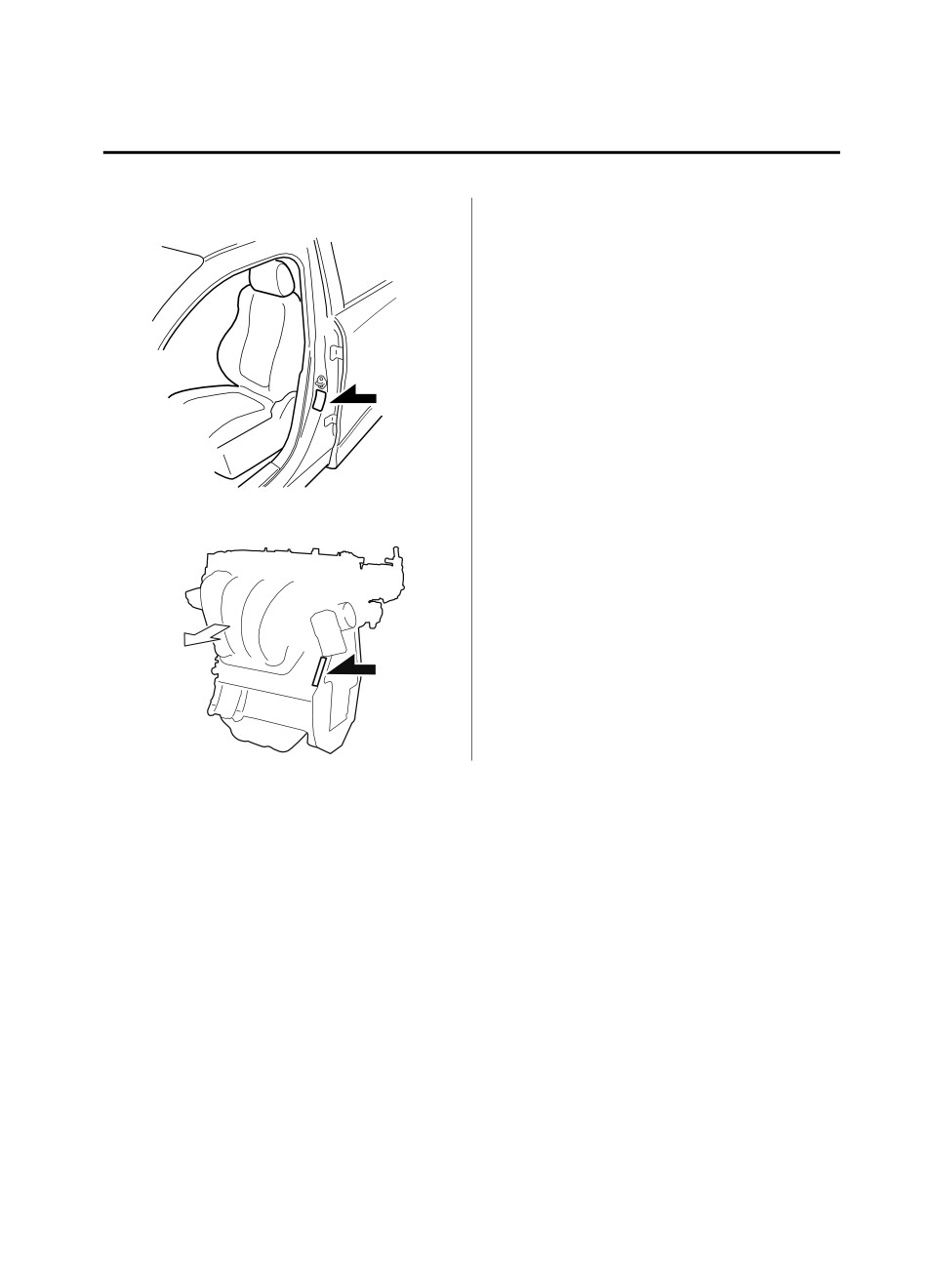
Specifications
Identification Numbers
▼ Tire Pressure Label
▼ Engine Number
Forward
9-3

Specifications
Specifications
Specifications
▼ Engine
Item
Specification
Type
DOHC-16V in-line, 4-cylinder
Bore × Stroke
89.0 × 100 mm (3.50 × 3.94 in)
Displacement
2,488.5 ml (2,488.5 cc)
Compression ratio
10.5
▼ Electrical System
Item
Classification
Battery*1
12V-60Ah/20HR or 12V-65Ah/20HR
Spark-plug number
Mazda Genuine spark plug*2
PY8V-18-110
*1
Check the battery installed on the vehicle and use a battery with an equal or higher performance. However, the
performance of the battery may vary even among the same battery types, consult an Authorized Mazda Dealer
for replacement.
*2
The spark plugs provide the SKYACTIV-G its optimum performance. Consult an Authorized Mazda Dealer
for details.
CAUTION
When cleaning the iridium plugs, do not use a wire brush. The fine particulate coating on the
iridium alloy and platinum tips could be damaged.
▼ Lubricant Quality
Lubricant
Classification
Engine oil
Refer to Recommended Oil on page 6-20.
Coolant
FL-22 type
Automatic transaxle fluid*1
Mazda Genuine ATF FZ
Transfer case oil*2
Mazda Long Life Hypoid Gear Oil SG1
Rear differential oil*2
Mazda Long Life Hypoid Gear Oil SG1
Brake fluid
SAE J1703 or FMVSS116 DOT-3
*1
Periodic replacement is unnecessary.
*2
Replacement is necessary when the component is submerged in water.
NOTE
Refer to Introduction on (page 6-2) for owner's responsibility in protecting your investment.
9-4
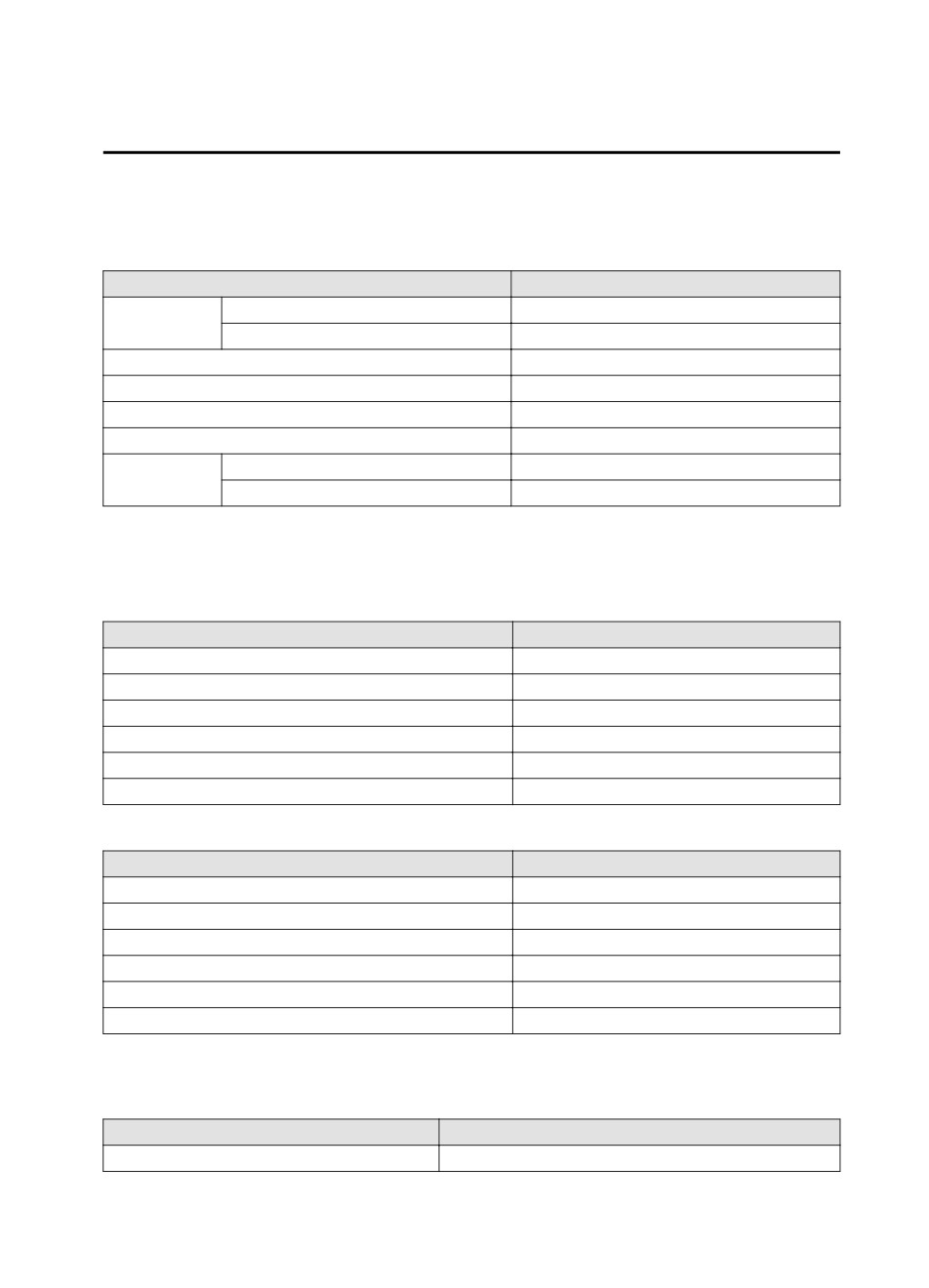
Specifications
Specifications
▼ Capacities
(Approximate Quantities)
Item
Capacity
With oil filter replacement
4.8 L (5.1 US qt, 4.2 Imp qt)
Engine oil
Without oil filter replacement
4.6 L (4.9 US qt, 4.0 Imp qt)
Coolant
9.9 L (10.5 US qt, 8.7 Imp qt)
Automatic transaxle fluid
8.0 L (8.5 US qt, 7.0 Imp qt)
Transfer case oil
0.45 L (0.48 US qt, 0.40 Imp qt)
Rear differential oil
0.35 L (0.37 US qt, 0.31 Imp qt)
FWD
72.0 L (19.0 US gal, 15.8 Imp gal)
Fuel tank
AWD
74.0 L (19.5 US gal, 16.3 Imp gal)
Check oil and fluid levels with dipsticks or reservoir gauges.
▼ Dimensions
U.S.A. and Canada
Item
Vehicle specification
Overall length
5,075 mm (199.8 in)
Overall width
1,969 mm (77.5 in)
Overall height
1,752 mm (69.0 in)
Front tread
1,659 mm (65.3 in)
Rear tread
1,656 mm (65.2 in)
Wheelbase
2,928 mm (115.3 in)
Mexico
Item
Vehicle specification
Overall length
5,075 mm (199.8 in)
Overall width
1,969 mm (77.5 in)
Overall height
1,747 mm (68.8 in)
Front tread
1,659 mm (65.3 in)
Rear tread
1,656 mm (65.2 in)
Wheelbase
2,928 mm (115.3 in)
▼ Weights
U.S.A. and Canada
Item
Weight
GVWR (Gross Vehicle Weight Rating)
2,641 kg (5,822 lbs)
9-5

Specifications
Specifications
Item
Weight
Front
1,250 kg (2,756 lbs)
GAWR (Gross Axle Weight Rating)
Rear
1,427 kg (3,146 lbs)
Mexico
Weight
Item
FWD
AWD
Total
2,495 kg (5,500 lbs)
2,565 kg (5,655 lbs)
GVW (Gross Vehicle Weight)
Front
1,180 kg (2,601 lbs)
1,205 kg (2,657 lbs)
Rear
1,315 kg (2,899 lbs)
1,360 kg (2,998 lbs)
Front
1,200 kg (2,646 lbs)
1,225 kg (2,701 lbs)
GAW (Permissible axle load)
Rear
1,370 kg (3,020 lbs)
1,420 kg (3,131 lbs)
▼ Light Bulbs
Exterior light
Category
Light bulb
Wattage
UN-R*1 (SAE)
Headlights
Daytime running lights
Parking lights*
Front side-marker lights*
Fog lights*
Signature wing illumination*
LED
― (―)
Side turn signal lights
High-mount brake light
Rear side-marker lights
Brake lights
Taillights
License plate lights
Parking lights/Front side-marker lights
*
5
WY5W (―)
LED type
LED
― (―)
Front turn signal lights
Bulb type
21
WY21W (7443NA)
Rear turn signal lights
21
WY21W (7443NA)
Reverse lights
16
W16W (921)
*1
UN-R stands for United Nations Regulation.
9-6
*Some models.
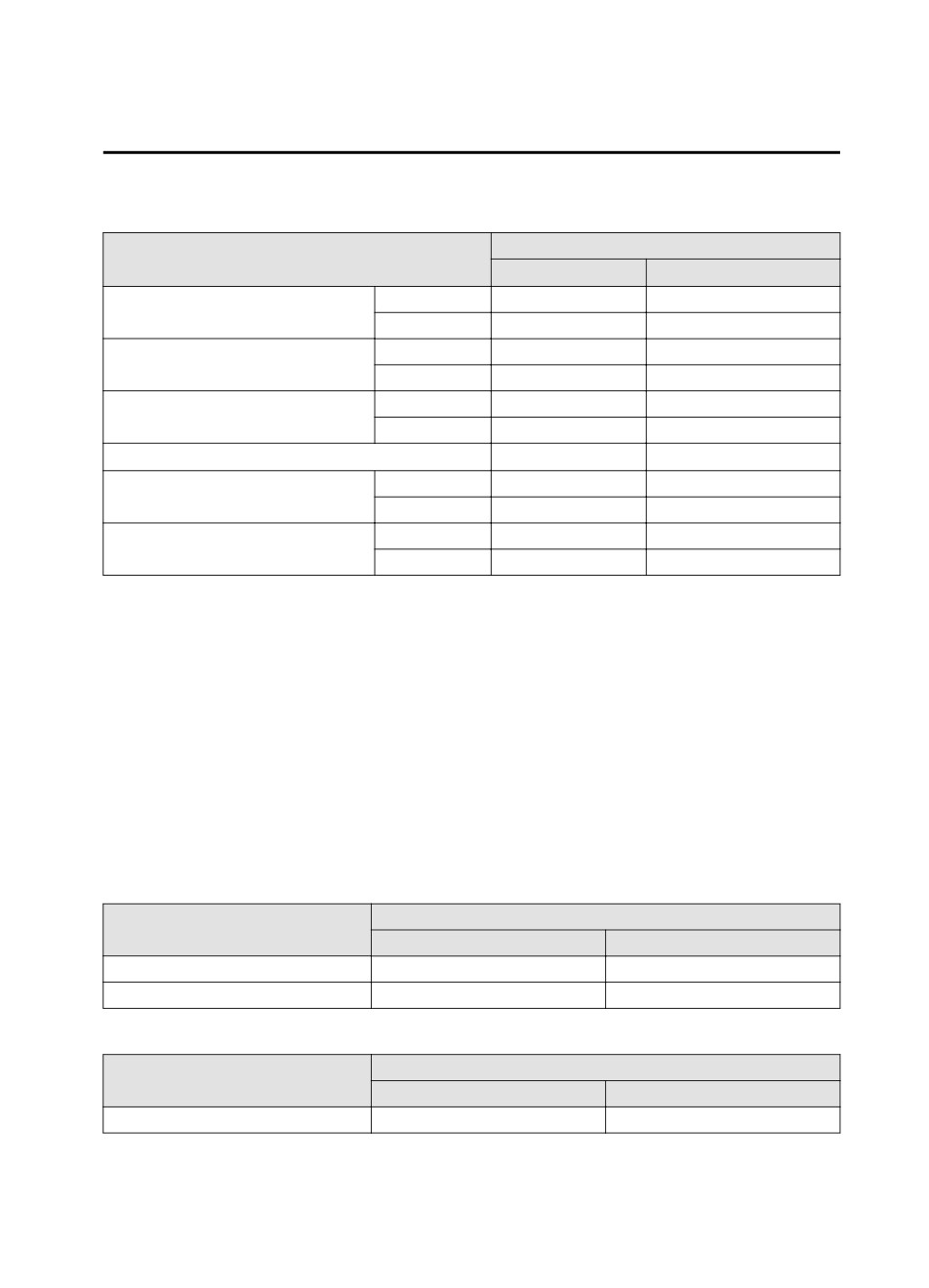
Specifications
Specifications
Interior light
Category
Light bulb
Wattage
UN-R*1
Overhead lights (Front)/Map lights
LED type
LED
―
(Front)
Bulb type
8
―
Overhead lights (Center)/Map lights
LED type
LED
―
(Center)
Bulb type
8
―
LED type
LED
―
Overhead light (Rear)
Bulb type
10
―
Ambient lights*
LED
―
LED type
LED
―
Vanity mirror lights*
Bulb type
2
―
LED type
LED
―
Luggage compartment light
Bulb type
8
―
*1
UN-R stands for United Nations Regulation.
▼ Tires
NOTE
The tires have been optimally matched with the chassis of your vehicle.
When replacing tires, Mazda recommends that you replace tires of the same type originally
fitted to your vehicle. For details, contact an Authorized Mazda Dealer.
Check the tire pressure label for tire size and inflation pressure.
Refer to Tire Inflation Pressure on page 6-34.
Standard tire
(U.S.A. and Canada)
Inflation pressure
Tire size
Front
Rear
P255/60R18 107H
230 kPa (34 psi)
230 kPa (34 psi)
P255/50R20 104V
230 kPa (34 psi)
230 kPa (34 psi)
(Mexico)
Inflation pressure
Tire size
Front
Rear
P255/50R20 104V
230 kPa (2.3 bar, 33 psi)
230 kPa (2.3 bar, 33 psi)
*Some models.
9-7

Specifications
Specifications
Temporary spare tire
(U.S.A. and Canada)
Tire size
Inflation pressure
T155/90D17 101M
420 kPa (60 psi)
(Mexico)
Tire size
Inflation pressure
185/80R17 99M
320 kPa (3.2 bar, 46 psi)
Lug nut tightening torque
When installing a tire, tighten the lug nut to the following torque.
108―147 N·m (12―14 kgf·m, 80―108 ft·lbf)
▼ Fuses
Refer to Fuses on page 6-46.
9-8
Большое спасибо!
Ваше мнение очень важно для нас.

Нет комментариевНе стесняйтесь поделиться с нами вашим ценным мнением.
Текст